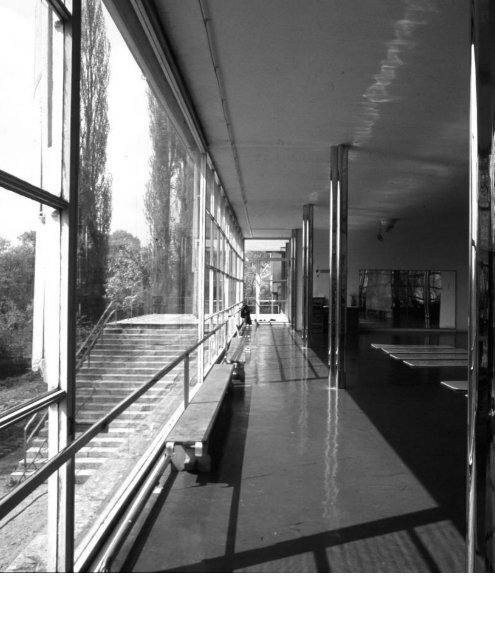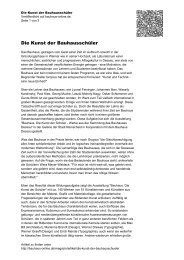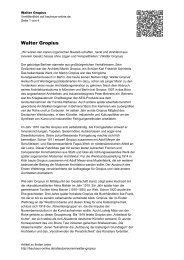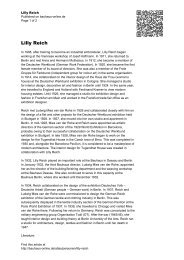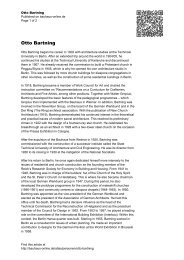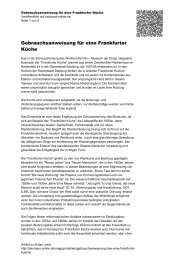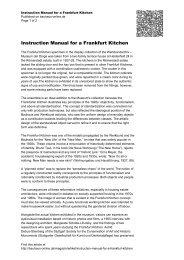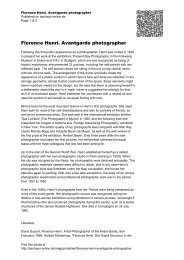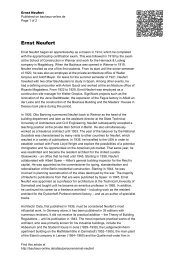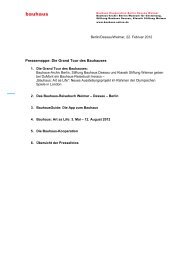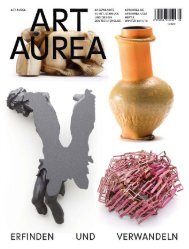Materiality of the Diaphane. Comments on the ... - Bauhaus Online
Materiality of the Diaphane. Comments on the ... - Bauhaus Online
Materiality of the Diaphane. Comments on the ... - Bauhaus Online
Create successful ePaper yourself
Turn your PDF publications into a flip-book with our unique Google optimized e-Paper software.
<str<strong>on</strong>g>Materiality</str<strong>on</strong>g> <str<strong>on</strong>g>of</str<strong>on</strong>g> <str<strong>on</strong>g>the</str<strong>on</strong>g> <str<strong>on</strong>g>Diaphane</str<strong>on</strong>g>.<br />
<str<strong>on</strong>g>Comments</str<strong>on</strong>g> <strong>on</strong> <str<strong>on</strong>g>the</str<strong>on</strong>g> Tugendhat House<br />
by Ludwig Mies van der Rohe and Lilly Reich<br />
Ivo Hammer<br />
Vienna<br />
The <str<strong>on</strong>g>the</str<strong>on</strong>g>me <str<strong>on</strong>g>of</str<strong>on</strong>g> my short c<strong>on</strong>tributi<strong>on</strong> relates to <str<strong>on</strong>g>the</str<strong>on</strong>g> inspiring article <str<strong>on</strong>g>of</str<strong>on</strong>g> M<strong>on</strong>ika<br />
Wagner in <str<strong>on</strong>g>the</str<strong>on</strong>g> internati<strong>on</strong>al c<strong>on</strong>ference titled <str<strong>on</strong>g>Materiality</str<strong>on</strong>g> in Brno in 2006, where -<br />
under <str<strong>on</strong>g>the</str<strong>on</strong>g> title material <str<strong>on</strong>g>of</str<strong>on</strong>g> <str<strong>on</strong>g>the</str<strong>on</strong>g> immaterial - she illustrates <str<strong>on</strong>g>the</str<strong>on</strong>g> importance <str<strong>on</strong>g>of</str<strong>on</strong>g> glass in<br />
<str<strong>on</strong>g>the</str<strong>on</strong>g> Tugendhat House in <str<strong>on</strong>g>the</str<strong>on</strong>g> c<strong>on</strong>text <str<strong>on</strong>g>of</str<strong>on</strong>g> c<strong>on</strong>temporary material aes<str<strong>on</strong>g>the</str<strong>on</strong>g>tics and<br />
shows how an ideal <str<strong>on</strong>g>of</str<strong>on</strong>g> <str<strong>on</strong>g>the</str<strong>on</strong>g> pictorial arts, namely <str<strong>on</strong>g>the</str<strong>on</strong>g> self-transcendence <str<strong>on</strong>g>of</str<strong>on</strong>g> <str<strong>on</strong>g>the</str<strong>on</strong>g> material,<br />
<str<strong>on</strong>g>the</str<strong>on</strong>g> intertwining <str<strong>on</strong>g>of</str<strong>on</strong>g> surface and depth, is transferred in <str<strong>on</strong>g>the</str<strong>on</strong>g> Tugendhat House<br />
into <str<strong>on</strong>g>the</str<strong>on</strong>g> architecture. 1<br />
DIAPHANE (CHARTRES)<br />
Perhaps <str<strong>on</strong>g>the</str<strong>on</strong>g> reference to <str<strong>on</strong>g>the</str<strong>on</strong>g> Gothic ca<str<strong>on</strong>g>the</str<strong>on</strong>g>drals Skelettgbauten is not quite inappropriate<br />
2 and <str<strong>on</strong>g>the</str<strong>on</strong>g> associati<strong>on</strong> with <str<strong>on</strong>g>the</str<strong>on</strong>g> famous characterizati<strong>on</strong> <str<strong>on</strong>g>of</str<strong>on</strong>g> <str<strong>on</strong>g>the</str<strong>on</strong>g>se structures<br />
as “diaphanous”, described by Jan Jantzen in 1927. 3 Jantzen specifies <str<strong>on</strong>g>the</str<strong>on</strong>g>se structures<br />
as walls <str<strong>on</strong>g>of</str<strong>on</strong>g> “dissolved in coloured light” and uses <str<strong>on</strong>g>the</str<strong>on</strong>g> term “Antip<strong>on</strong>deros”<br />
(which means something like <str<strong>on</strong>g>the</str<strong>on</strong>g> opposite <str<strong>on</strong>g>of</str<strong>on</strong>g> grevic, weighty) as essential style element<br />
<str<strong>on</strong>g>of</str<strong>on</strong>g> <str<strong>on</strong>g>the</str<strong>on</strong>g> “spiritualized Area”. The windows are in fact both d<strong>on</strong>or <str<strong>on</strong>g>of</str<strong>on</strong>g> light and<br />
image plane. In Chartres, for example, <str<strong>on</strong>g>the</str<strong>on</strong>g>re are <str<strong>on</strong>g>the</str<strong>on</strong>g> translucent “tapestries” and <str<strong>on</strong>g>the</str<strong>on</strong>g>ir<br />
spiritual messages, whereas in <str<strong>on</strong>g>the</str<strong>on</strong>g> Tugendhat House <str<strong>on</strong>g>the</str<strong>on</strong>g> physical nature itself becomes<br />
an image, <str<strong>on</strong>g>the</str<strong>on</strong>g> branches <str<strong>on</strong>g>of</str<strong>on</strong>g> <str<strong>on</strong>g>the</str<strong>on</strong>g> plants <str<strong>on</strong>g>of</str<strong>on</strong>g> <str<strong>on</strong>g>the</str<strong>on</strong>g> winter garden appear as lead<br />
comes <str<strong>on</strong>g>of</str<strong>on</strong>g> Gothic stained glass windows, <str<strong>on</strong>g>the</str<strong>on</strong>g> colourful leaves as <str<strong>on</strong>g>the</str<strong>on</strong>g> coloured glass.<br />
TUGENDHAT HOUSE<br />
Given <str<strong>on</strong>g>the</str<strong>on</strong>g> exuberant literature <strong>on</strong> LMvdR in general and <strong>on</strong> <str<strong>on</strong>g>the</str<strong>on</strong>g> Tugendhat House<br />
in particular, it may be justifiable to ask if <str<strong>on</strong>g>the</str<strong>on</strong>g>re is anything new I can <str<strong>on</strong>g>of</str<strong>on</strong>g>fer you.<br />
Infact, <str<strong>on</strong>g>the</str<strong>on</strong>g>re are many astute analyses <str<strong>on</strong>g>of</str<strong>on</strong>g> <str<strong>on</strong>g>the</str<strong>on</strong>g> spatial structure and <str<strong>on</strong>g>the</str<strong>on</strong>g> design and its<br />
importance in <str<strong>on</strong>g>the</str<strong>on</strong>g> history <str<strong>on</strong>g>of</str<strong>on</strong>g> architecture. The few publicati<strong>on</strong>s that deal at all with<br />
<str<strong>on</strong>g>the</str<strong>on</strong>g> materials, such as <str<strong>on</strong>g>the</str<strong>on</strong>g> apparently little-known publicati<strong>on</strong> by Yilmaz Dwesior
4<br />
Academy <str<strong>on</strong>g>of</str<strong>on</strong>g> Architecture – Università della Svizzera italiana<br />
Ivo Hammer<br />
Chartres, ca<str<strong>on</strong>g>the</str<strong>on</strong>g>dral,<br />
north-east chapel <str<strong>on</strong>g>of</str<strong>on</strong>g> <str<strong>on</strong>g>the</str<strong>on</strong>g><br />
ambulatory; <str<strong>on</strong>g>the</str<strong>on</strong>g><br />
architectural surface and<br />
<str<strong>on</strong>g>the</str<strong>on</strong>g> stained glass <str<strong>on</strong>g>of</str<strong>on</strong>g> this<br />
chapel was<br />
restored recently.<br />
(Photo Ivo Hammer<br />
2009).<br />
Brno, Tugendhat<br />
House, 1928-30,<br />
Ludwig Mies van der<br />
Rohe and Lilly Reich,<br />
Living Room view<br />
toward east side.<br />
(Photo Fritz Tugendhat<br />
1930)
The Glass in <str<strong>on</strong>g>the</str<strong>on</strong>g> 20th Century Architecture: Preservati<strong>on</strong> and Restorati<strong>on</strong><br />
<strong>on</strong> <str<strong>on</strong>g>the</str<strong>on</strong>g> glass in <str<strong>on</strong>g>the</str<strong>on</strong>g> c<strong>on</strong>text <str<strong>on</strong>g>of</str<strong>on</strong>g> Mies van der Rohe architecture 4 relate more to ic<strong>on</strong>ographic<br />
questi<strong>on</strong>s as to <str<strong>on</strong>g>the</str<strong>on</strong>g> tangible materials <str<strong>on</strong>g>of</str<strong>on</strong>g> structures and <str<strong>on</strong>g>the</str<strong>on</strong>g> materiality <str<strong>on</strong>g>of</str<strong>on</strong>g> architecture.Our<br />
Western culture, dominated by Christian culture neglected <str<strong>on</strong>g>the</str<strong>on</strong>g> matter in<br />
philosophical as well as in practical terms and gives primacy to <str<strong>on</strong>g>the</str<strong>on</strong>g> spirit, to <str<strong>on</strong>g>the</str<strong>on</strong>g> idea.<br />
And <str<strong>on</strong>g>the</str<strong>on</strong>g> currently growing emphasis <strong>on</strong> <str<strong>on</strong>g>the</str<strong>on</strong>g> evidence in cultural studies and specifically<br />
in aes<str<strong>on</strong>g>the</str<strong>on</strong>g>tic discourse has hardly been matched by a c<strong>on</strong>crete scientific engagement<br />
with <str<strong>on</strong>g>the</str<strong>on</strong>g> material base <str<strong>on</strong>g>of</str<strong>on</strong>g> artefacts. 5<br />
M<strong>on</strong>ika Wagner states: «Since Plato and Aristotle, European art history has paid<br />
little attenti<strong>on</strong> to <str<strong>on</strong>g>the</str<strong>on</strong>g> materials <str<strong>on</strong>g>of</str<strong>on</strong>g> which <str<strong>on</strong>g>of</str<strong>on</strong>g> artworks are made. Aes<str<strong>on</strong>g>the</str<strong>on</strong>g>tic <str<strong>on</strong>g>the</str<strong>on</strong>g>ory<br />
has l<strong>on</strong>g regarded material as <str<strong>on</strong>g>the</str<strong>on</strong>g> medium <str<strong>on</strong>g>of</str<strong>on</strong>g> form and not something meant to be<br />
c<strong>on</strong>sciously perceived as part <str<strong>on</strong>g>of</str<strong>on</strong>g> <str<strong>on</strong>g>the</str<strong>on</strong>g> meaning <str<strong>on</strong>g>of</str<strong>on</strong>g> <str<strong>on</strong>g>the</str<strong>on</strong>g> artwork». 6<br />
Given this situati<strong>on</strong>, I find it gratifying when a scientific c<strong>on</strong>ference is dedicated to<br />
a specific building material like glass.<br />
Focus <str<strong>on</strong>g>of</str<strong>on</strong>g> my c<strong>on</strong>tributi<strong>on</strong> is materiality <str<strong>on</strong>g>of</str<strong>on</strong>g> <str<strong>on</strong>g>the</str<strong>on</strong>g> aes<str<strong>on</strong>g>the</str<strong>on</strong>g>tic orchestrati<strong>on</strong> <str<strong>on</strong>g>of</str<strong>on</strong>g> space and<br />
its limits. I would like to try <str<strong>on</strong>g>the</str<strong>on</strong>g> following definiti<strong>on</strong> <str<strong>on</strong>g>of</str<strong>on</strong>g> <str<strong>on</strong>g>the</str<strong>on</strong>g> term materiality. <str<strong>on</strong>g>Materiality</str<strong>on</strong>g><br />
<str<strong>on</strong>g>of</str<strong>on</strong>g> art is <str<strong>on</strong>g>the</str<strong>on</strong>g> manifestati<strong>on</strong> <str<strong>on</strong>g>of</str<strong>on</strong>g> historical, artistic and o<str<strong>on</strong>g>the</str<strong>on</strong>g>r cultural properties<br />
in <str<strong>on</strong>g>the</str<strong>on</strong>g> material substance <str<strong>on</strong>g>of</str<strong>on</strong>g> arts, <str<strong>on</strong>g>the</str<strong>on</strong>g>ir techniques and <str<strong>on</strong>g>the</str<strong>on</strong>g>ir surfaces. Accordingly,<br />
<str<strong>on</strong>g>the</str<strong>on</strong>g> matter <str<strong>on</strong>g>of</str<strong>on</strong>g> a work <str<strong>on</strong>g>of</str<strong>on</strong>g> fine art is to be c<strong>on</strong>sidered dialectically: <strong>on</strong>e <str<strong>on</strong>g>the</str<strong>on</strong>g> <strong>on</strong>e hand<br />
as a technology <str<strong>on</strong>g>of</str<strong>on</strong>g> matter with determined elements in a certain compound, <str<strong>on</strong>g>of</str<strong>on</strong>g><br />
surface appearance (including colour, structure, texture and facture), <str<strong>on</strong>g>of</str<strong>on</strong>g> aging and<br />
<str<strong>on</strong>g>of</str<strong>on</strong>g> deliberate, anthropogenic change and - <strong>on</strong> <str<strong>on</strong>g>the</str<strong>on</strong>g> o<str<strong>on</strong>g>the</str<strong>on</strong>g>r hand - as a matter <str<strong>on</strong>g>of</str<strong>on</strong>g> design<br />
with a specific subject, purpose, form, c<strong>on</strong>text, c<strong>on</strong>tent and recepti<strong>on</strong> horiz<strong>on</strong>.<br />
The thing, <str<strong>on</strong>g>the</str<strong>on</strong>g> matter is indissolubly linked with <str<strong>on</strong>g>the</str<strong>on</strong>g> idea, it is not just an arbitrary<br />
character or sign documenting cultural ideas. 7<br />
Preservati<strong>on</strong> and c<strong>on</strong>servati<strong>on</strong> <str<strong>on</strong>g>of</str<strong>on</strong>g> <str<strong>on</strong>g>the</str<strong>on</strong>g> material substrate <str<strong>on</strong>g>of</str<strong>on</strong>g> cultural heritage make<br />
sense <strong>on</strong>ly, if <str<strong>on</strong>g>the</str<strong>on</strong>g>y are understood as au<str<strong>on</strong>g>the</str<strong>on</strong>g>ntic resource <str<strong>on</strong>g>of</str<strong>on</strong>g> historical, artistic and<br />
o<str<strong>on</strong>g>the</str<strong>on</strong>g>r cultural attributes and designs materialized in <str<strong>on</strong>g>the</str<strong>on</strong>g> fabric <str<strong>on</strong>g>of</str<strong>on</strong>g> <str<strong>on</strong>g>the</str<strong>on</strong>g> m<strong>on</strong>ument<br />
and its surface.<br />
HAWK ETC.<br />
Since 2003, <str<strong>on</strong>g>the</str<strong>on</strong>g> HAWK University <str<strong>on</strong>g>of</str<strong>on</strong>g> Applied Arts and Sciences in Hildesheim,<br />
Germany - (since 2005 toge<str<strong>on</strong>g>the</str<strong>on</strong>g>r with o<str<strong>on</strong>g>the</str<strong>on</strong>g>r Universities <str<strong>on</strong>g>of</str<strong>on</strong>g> Pardubice, Brno, Cologne,<br />
Dresden and Vienna) - has been performing a scientific c<strong>on</strong>servati<strong>on</strong> investigati<strong>on</strong><br />
c<strong>on</strong>cerning <str<strong>on</strong>g>the</str<strong>on</strong>g> Tugendhat House <str<strong>on</strong>g>of</str<strong>on</strong>g> Ludwig Mies van der Rohe and Lilly<br />
Reich. The interdisciplinary investigati<strong>on</strong>s were c<strong>on</strong>cerning <str<strong>on</strong>g>the</str<strong>on</strong>g> materials, techniques<br />
and surfaces <str<strong>on</strong>g>of</str<strong>on</strong>g> all different original materials, <str<strong>on</strong>g>the</str<strong>on</strong>g> materials and surfaces <str<strong>on</strong>g>of</str<strong>on</strong>g><br />
<str<strong>on</strong>g>Materiality</str<strong>on</strong>g> <str<strong>on</strong>g>of</str<strong>on</strong>g> <str<strong>on</strong>g>the</str<strong>on</strong>g> <str<strong>on</strong>g>Diaphane</str<strong>on</strong>g>. <str<strong>on</strong>g>Comments</str<strong>on</strong>g> <strong>on</strong> <str<strong>on</strong>g>the</str<strong>on</strong>g> Tugendhat House by Ludwig Mies van der Rohe and<br />
Lilly Reich<br />
5
6<br />
Academy <str<strong>on</strong>g>of</str<strong>on</strong>g> Architecture – Università della Svizzera italiana<br />
later repairs, <str<strong>on</strong>g>the</str<strong>on</strong>g> state <str<strong>on</strong>g>of</str<strong>on</strong>g> c<strong>on</strong>servati<strong>on</strong> and <str<strong>on</strong>g>the</str<strong>on</strong>g> damages and - last but not least, <str<strong>on</strong>g>the</str<strong>on</strong>g><br />
methods and techniques <str<strong>on</strong>g>of</str<strong>on</strong>g> c<strong>on</strong>servati<strong>on</strong>, repair and - finally - maintenance. We<br />
called it CIC (C<strong>on</strong>servati<strong>on</strong> Investigat<strong>on</strong> Campaign). But <str<strong>on</strong>g>the</str<strong>on</strong>g>re is a paradox. We<br />
have examined <strong>on</strong>ly <str<strong>on</strong>g>the</str<strong>on</strong>g> materials and surfaces still preserved originally. And just<br />
<str<strong>on</strong>g>the</str<strong>on</strong>g> original glazings are not preserved - at least as far as we know. This is even<br />
more painful in view <str<strong>on</strong>g>of</str<strong>on</strong>g> <str<strong>on</strong>g>the</str<strong>on</strong>g> fact that glass has a special meaning in architecture by<br />
Ludwig Mies van der Rohe and Lilly Reich.<br />
TOWER FRIEDRICHSTRASSE, GLASS ROOM<br />
Since 1986, through <str<strong>on</strong>g>the</str<strong>on</strong>g> publicati<strong>on</strong> <str<strong>on</strong>g>of</str<strong>on</strong>g> Fritz Neumeyer, we know <str<strong>on</strong>g>the</str<strong>on</strong>g> dictum <str<strong>on</strong>g>of</str<strong>on</strong>g><br />
LMvdR <str<strong>on</strong>g>of</str<strong>on</strong>g> 1933: «What would be c<strong>on</strong>crete, what steel, without plate glass?» 8<br />
As early as 1922, LMvdR published a first fundamental argument c<strong>on</strong>cerning glass<br />
as building material, 9 apparently in c<strong>on</strong>necti<strong>on</strong> with his design project for Berlin’s<br />
high-rise building Friedrichstrasse in 1921. 10<br />
LMvdR writes: «Skyscrapers show <str<strong>on</strong>g>the</str<strong>on</strong>g> bold c<strong>on</strong>structive thoughts <strong>on</strong>ly under c<strong>on</strong>structi<strong>on</strong>»<br />
and adds, that <str<strong>on</strong>g>the</str<strong>on</strong>g>se bold thoughts are «<str<strong>on</strong>g>the</str<strong>on</strong>g> necessary foundati<strong>on</strong> for <str<strong>on</strong>g>the</str<strong>on</strong>g><br />
artistic design». MvdR specifies: «The principle <str<strong>on</strong>g>of</str<strong>on</strong>g> this new type <str<strong>on</strong>g>of</str<strong>on</strong>g> buildings shall<br />
be clear, if glass is used for <str<strong>on</strong>g>the</str<strong>on</strong>g> no l<strong>on</strong>ger supporting exterior walls. But <str<strong>on</strong>g>the</str<strong>on</strong>g> use <str<strong>on</strong>g>of</str<strong>on</strong>g><br />
glass forces to take new ways . « [...] Mies also seeks - as he calls it – to avoid dead<br />
appearance that <str<strong>on</strong>g>of</str<strong>on</strong>g>ten arises in <str<strong>on</strong>g>the</str<strong>on</strong>g> use <str<strong>on</strong>g>of</str<strong>on</strong>g> glass in large spans», and he c<strong>on</strong>tinues:<br />
«My experiments in a glass model showed me <str<strong>on</strong>g>the</str<strong>on</strong>g> way, and I so<strong>on</strong> realized that<br />
with <str<strong>on</strong>g>the</str<strong>on</strong>g> use <str<strong>on</strong>g>of</str<strong>on</strong>g> glass it is not important to achieve an effect <str<strong>on</strong>g>of</str<strong>on</strong>g> light and shadow,<br />
but to a rich play <str<strong>on</strong>g>of</str<strong>on</strong>g> reflecti<strong>on</strong>s». 11<br />
These words <str<strong>on</strong>g>of</str<strong>on</strong>g> <str<strong>on</strong>g>the</str<strong>on</strong>g> artist, who worked since 1926 intensively with his peer colleague<br />
and partner Lilly Reich, suggest a topic that can bring <str<strong>on</strong>g>the</str<strong>on</strong>g> music <str<strong>on</strong>g>of</str<strong>on</strong>g> <str<strong>on</strong>g>the</str<strong>on</strong>g> artwork<br />
to sound, if you look at - to stay in <str<strong>on</strong>g>the</str<strong>on</strong>g> picture - <str<strong>on</strong>g>the</str<strong>on</strong>g> actual chords, <str<strong>on</strong>g>the</str<strong>on</strong>g>ir<br />
sounds, <str<strong>on</strong>g>the</str<strong>on</strong>g>ir rhythm and <str<strong>on</strong>g>the</str<strong>on</strong>g>ir performance: In o<str<strong>on</strong>g>the</str<strong>on</strong>g>r words: if you look at <str<strong>on</strong>g>the</str<strong>on</strong>g> play<br />
<str<strong>on</strong>g>of</str<strong>on</strong>g> space, materials and light, transparency and reflecti<strong>on</strong> <str<strong>on</strong>g>of</str<strong>on</strong>g> light.<br />
You know <str<strong>on</strong>g>the</str<strong>on</strong>g> Glass Room <str<strong>on</strong>g>of</str<strong>on</strong>g> (Deutscher Verein für Spiegelglas-Fabriken) <str<strong>on</strong>g>the</str<strong>on</strong>g> German<br />
Associati<strong>on</strong> <str<strong>on</strong>g>of</str<strong>on</strong>g> Plate-Glass Factories in <str<strong>on</strong>g>the</str<strong>on</strong>g> Exhibiti<strong>on</strong> <str<strong>on</strong>g>of</str<strong>on</strong>g> 1927, <str<strong>on</strong>g>the</str<strong>on</strong>g> Werkbund exhibiti<strong>on</strong><br />
in Stuttgart trade designed by Lilly Reich toge<str<strong>on</strong>g>the</str<strong>on</strong>g>r with LMvdR (Lilly<br />
Reich is quoted in <str<strong>on</strong>g>the</str<strong>on</strong>g> catalogue, c<strong>on</strong>trary to <str<strong>on</strong>g>the</str<strong>on</strong>g> alphabet first before LMvdR). 12<br />
and <str<strong>on</strong>g>of</str<strong>on</strong>g> course The Barcel<strong>on</strong>a Pavili<strong>on</strong> and <str<strong>on</strong>g>the</str<strong>on</strong>g>ir importance regarding <str<strong>on</strong>g>the</str<strong>on</strong>g> history<br />
<str<strong>on</strong>g>of</str<strong>on</strong>g> glass architecture in general and regarding <str<strong>on</strong>g>the</str<strong>on</strong>g> development <str<strong>on</strong>g>of</str<strong>on</strong>g> <str<strong>on</strong>g>the</str<strong>on</strong>g> artistic principles<br />
<str<strong>on</strong>g>of</str<strong>on</strong>g> LMvdR and Lilly Reich. The Barcel<strong>on</strong>a pavili<strong>on</strong>, as you know, was not <str<strong>on</strong>g>the</str<strong>on</strong>g><br />
planning basis for <str<strong>on</strong>g>the</str<strong>on</strong>g> Tugendhat House, which was planned since September<br />
1928. The essential planning phase <str<strong>on</strong>g>of</str<strong>on</strong>g> <str<strong>on</strong>g>the</str<strong>on</strong>g> Barcel<strong>on</strong>a pavili<strong>on</strong> took place in <str<strong>on</strong>g>the</str<strong>on</strong>g> turn<br />
<str<strong>on</strong>g>of</str<strong>on</strong>g> 1928/29, when <str<strong>on</strong>g>the</str<strong>on</strong>g> planning for Tugendhat House was ready for c<strong>on</strong>structi<strong>on</strong>. 13<br />
Ivo Hammer
Brno, Tugendhat<br />
House, 1928-30 Ludwig<br />
Mies van der Rohe and<br />
Lilly Reich.<br />
First floor.<br />
Brno, Tugendhat<br />
House, 1928-30 Ludwig<br />
Mies van der Rohe and<br />
Lilly Reich.<br />
Ground floor.<br />
The Glass in <str<strong>on</strong>g>the</str<strong>on</strong>g> 20th Century Architecture: Preservati<strong>on</strong> and Restorati<strong>on</strong><br />
TUGENDHAT HOUSE<br />
What do we know about <str<strong>on</strong>g>the</str<strong>on</strong>g> use <str<strong>on</strong>g>of</str<strong>on</strong>g> glass in <str<strong>on</strong>g>the</str<strong>on</strong>g> Tugendhat House?<br />
<str<strong>on</strong>g>Materiality</str<strong>on</strong>g> <str<strong>on</strong>g>of</str<strong>on</strong>g> <str<strong>on</strong>g>the</str<strong>on</strong>g> <str<strong>on</strong>g>Diaphane</str<strong>on</strong>g>. <str<strong>on</strong>g>Comments</str<strong>on</strong>g> <strong>on</strong> <str<strong>on</strong>g>the</str<strong>on</strong>g> Tugendhat House by Ludwig Mies van der Rohe and<br />
Lilly Reich<br />
7
8<br />
Academy <str<strong>on</strong>g>of</str<strong>on</strong>g> Architecture – Università della Svizzera italiana<br />
Ivo Hammer<br />
Tugendhat House<br />
External view<br />
Tugendhat House<br />
External view
The Glass in <str<strong>on</strong>g>the</str<strong>on</strong>g> 20th Century Architecture: Preservati<strong>on</strong> and Restorati<strong>on</strong><br />
Crystal mirror glass<br />
The big glass walls <str<strong>on</strong>g>of</str<strong>on</strong>g> <str<strong>on</strong>g>the</str<strong>on</strong>g> living room c<strong>on</strong>sist <str<strong>on</strong>g>of</str<strong>on</strong>g> extremely large span crystal mirror<br />
glazing: <strong>on</strong> <str<strong>on</strong>g>the</str<strong>on</strong>g> south 3 panels <str<strong>on</strong>g>of</str<strong>on</strong>g> 3 x 4.9 m, 2 lateral panels <str<strong>on</strong>g>the</str<strong>on</strong>g> western <strong>on</strong>e <str<strong>on</strong>g>of</str<strong>on</strong>g> 2.9 m,<br />
2.7 m <str<strong>on</strong>g>of</str<strong>on</strong>g> <str<strong>on</strong>g>the</str<strong>on</strong>g> sou<str<strong>on</strong>g>the</str<strong>on</strong>g>rn <strong>on</strong>e, <str<strong>on</strong>g>the</str<strong>on</strong>g> thickness <str<strong>on</strong>g>of</str<strong>on</strong>g> <str<strong>on</strong>g>the</str<strong>on</strong>g> glass is about 10 mm. Two panels<br />
can roll down. The rolling mechanism is electric, <str<strong>on</strong>g>the</str<strong>on</strong>g> c<strong>on</strong>trol panel butt<strong>on</strong>s are situated<br />
<strong>on</strong> <str<strong>on</strong>g>the</str<strong>on</strong>g> west wall dining space: The window panels slip down into <str<strong>on</strong>g>the</str<strong>on</strong>g> basement<br />
space and sink up to floor level completely. The mechanism is still working.<br />
Winter garden last glazing<br />
The east wall c<strong>on</strong>sists <str<strong>on</strong>g>of</str<strong>on</strong>g> four panels, two <str<strong>on</strong>g>of</str<strong>on</strong>g> <str<strong>on</strong>g>the</str<strong>on</strong>g>m even bigger than <str<strong>on</strong>g>the</str<strong>on</strong>g> glass panels<br />
<str<strong>on</strong>g>of</str<strong>on</strong>g> <str<strong>on</strong>g>the</str<strong>on</strong>g> south wall: 3 x 5.52 m. These big panels were stupendously flat, <str<strong>on</strong>g>the</str<strong>on</strong>g>re is<br />
no optical un-eveness. The last glazing was destroyed in 1985.<br />
Children, rain<br />
The optical evenness could <strong>on</strong>ly be changed with <str<strong>on</strong>g>the</str<strong>on</strong>g> raindrops <strong>on</strong> <str<strong>on</strong>g>the</str<strong>on</strong>g> glass ... The<br />
photograph <str<strong>on</strong>g>of</str<strong>on</strong>g> Fritz Tugendhat is showing <str<strong>on</strong>g>the</str<strong>on</strong>g> children and Herbert Ernst aprox<br />
in 1936, two years before <str<strong>on</strong>g>the</str<strong>on</strong>g> family had to leave <str<strong>on</strong>g>the</str<strong>on</strong>g> house <str<strong>on</strong>g>the</str<strong>on</strong>g> escape <str<strong>on</strong>g>the</str<strong>on</strong>g> upcoming<br />
German Nazis.<br />
Original piece?<br />
During <str<strong>on</strong>g>the</str<strong>on</strong>g> rec<strong>on</strong>structi<strong>on</strong> works in 2010 a piece <str<strong>on</strong>g>of</str<strong>on</strong>g> plate glass was found, which<br />
might be part <str<strong>on</strong>g>of</str<strong>on</strong>g> <str<strong>on</strong>g>the</str<strong>on</strong>g> original big panels (10 mm thickness). The glass has a slightly<br />
greenish t<strong>on</strong>e.<br />
Plate glass doors and windows<br />
12 doors, 1 m wide, were glazed (2 <str<strong>on</strong>g>of</str<strong>on</strong>g> winter garden, entrance staircase, entrance<br />
terrace, kitchen entrance, entrance hall, door to <str<strong>on</strong>g>the</str<strong>on</strong>g> terrace, doors <str<strong>on</strong>g>of</str<strong>on</strong>g> sleeping<br />
rooms towards <str<strong>on</strong>g>the</str<strong>on</strong>g> terrace). As we can recognize in <str<strong>on</strong>g>the</str<strong>on</strong>g> photograph e.g. <str<strong>on</strong>g>of</str<strong>on</strong>g> <str<strong>on</strong>g>the</str<strong>on</strong>g><br />
room <str<strong>on</strong>g>of</str<strong>on</strong>g> Fritz Tugendhat, <str<strong>on</strong>g>the</str<strong>on</strong>g> glazing <str<strong>on</strong>g>of</str<strong>on</strong>g> <str<strong>on</strong>g>the</str<strong>on</strong>g> doors and windows c<strong>on</strong>sisted <str<strong>on</strong>g>of</str<strong>on</strong>g> plate<br />
glass. All <str<strong>on</strong>g>the</str<strong>on</strong>g> steel framing is original.<br />
Dessau desk<br />
Regarding <str<strong>on</strong>g>the</str<strong>on</strong>g> clear glass panels we should not forget <str<strong>on</strong>g>the</str<strong>on</strong>g> Dessau Table in fr<strong>on</strong>t <str<strong>on</strong>g>of</str<strong>on</strong>g><br />
<str<strong>on</strong>g>the</str<strong>on</strong>g> <strong>on</strong>yx marble wall (an original peace <str<strong>on</strong>g>of</str<strong>on</strong>g> this glass is property <str<strong>on</strong>g>of</str<strong>on</strong>g> Knoll Internati<strong>on</strong>al,<br />
New York. 14<br />
<str<strong>on</strong>g>Materiality</str<strong>on</strong>g> <str<strong>on</strong>g>of</str<strong>on</strong>g> <str<strong>on</strong>g>the</str<strong>on</strong>g> <str<strong>on</strong>g>Diaphane</str<strong>on</strong>g>. <str<strong>on</strong>g>Comments</str<strong>on</strong>g> <strong>on</strong> <str<strong>on</strong>g>the</str<strong>on</strong>g> Tugendhat House by Ludwig Mies van der Rohe and<br />
Lilly Reich<br />
9
10<br />
Academy <str<strong>on</strong>g>of</str<strong>on</strong>g> Architecture – Università della Svizzera italiana<br />
Bookshelf Fritz T.<br />
The glass sliding doors <str<strong>on</strong>g>of</str<strong>on</strong>g> <str<strong>on</strong>g>the</str<strong>on</strong>g> bookshelf in <str<strong>on</strong>g>the</str<strong>on</strong>g> room <str<strong>on</strong>g>of</str<strong>on</strong>g> Fritz Tugendhat probably<br />
c<strong>on</strong>sisted <str<strong>on</strong>g>of</str<strong>on</strong>g> plate glass, <str<strong>on</strong>g>the</str<strong>on</strong>g>y are not preserved, <str<strong>on</strong>g>the</str<strong>on</strong>g> actual <strong>on</strong>es are copies.<br />
Lamp<br />
Just for curiosity I may recall <str<strong>on</strong>g>the</str<strong>on</strong>g> base <str<strong>on</strong>g>of</str<strong>on</strong>g> <str<strong>on</strong>g>the</str<strong>on</strong>g> lamp <strong>on</strong> <str<strong>on</strong>g>the</str<strong>on</strong>g> writing desk in <str<strong>on</strong>g>the</str<strong>on</strong>g> library,<br />
c<strong>on</strong>sisting <str<strong>on</strong>g>of</str<strong>on</strong>g> a (perhaps blown) glass vase filled with water<br />
Opaque glazing: entrance wall<br />
A special problem regarding <str<strong>on</strong>g>the</str<strong>on</strong>g> knowledge <str<strong>on</strong>g>of</str<strong>on</strong>g> <str<strong>on</strong>g>the</str<strong>on</strong>g> original material are <str<strong>on</strong>g>the</str<strong>on</strong>g> opaque<br />
glasses <str<strong>on</strong>g>of</str<strong>on</strong>g> <str<strong>on</strong>g>the</str<strong>on</strong>g> Tugendhat House. The glass wall is partly bent, <str<strong>on</strong>g>the</str<strong>on</strong>g> steel perimeter<br />
frame with columns have a span <str<strong>on</strong>g>of</str<strong>on</strong>g> 3 x 1,72 m. The photographs <str<strong>on</strong>g>of</str<strong>on</strong>g> <str<strong>on</strong>g>the</str<strong>on</strong>g> entrance<br />
wall show a glossy surface and a certain opaqueness which allows to appear in a<br />
general way <str<strong>on</strong>g>the</str<strong>on</strong>g> chiaroscuro <str<strong>on</strong>g>of</str<strong>on</strong>g> <str<strong>on</strong>g>the</str<strong>on</strong>g> interior, that is <str<strong>on</strong>g>the</str<strong>on</strong>g> dark and bright parts <str<strong>on</strong>g>of</str<strong>on</strong>g> <str<strong>on</strong>g>the</str<strong>on</strong>g><br />
entrance hall.<br />
Ivo Hammer<br />
Tugendhat House<br />
Original piece?<br />
Tugendhat House<br />
Plate glass table.<br />
Tugendhat House<br />
Book storage regal <str<strong>on</strong>g>of</str<strong>on</strong>g><br />
Fritz Tugendhat: Lilly<br />
Reich.
Tugendhat<br />
House<br />
Opaque glass:<br />
etched, flashed<br />
or made<br />
opaque by<br />
additi<strong>on</strong>s?<br />
The Glass in <str<strong>on</strong>g>the</str<strong>on</strong>g> 20th Century Architecture: Preservati<strong>on</strong> and Restorati<strong>on</strong><br />
Entrance wall, exterior: semi-traslucent?<br />
In <strong>on</strong>e photograph it seems be so translucent that <str<strong>on</strong>g>the</str<strong>on</strong>g> difference between <str<strong>on</strong>g>the</str<strong>on</strong>g> wall<br />
<str<strong>on</strong>g>of</str<strong>on</strong>g> <str<strong>on</strong>g>the</str<strong>on</strong>g> corridor and <str<strong>on</strong>g>the</str<strong>on</strong>g> void <str<strong>on</strong>g>of</str<strong>on</strong>g> <str<strong>on</strong>g>the</str<strong>on</strong>g> entrance hall can be perceived; c<strong>on</strong>sequently a<br />
pers<strong>on</strong> passing by in <str<strong>on</strong>g>the</str<strong>on</strong>g> corridor e.g. from <str<strong>on</strong>g>the</str<strong>on</strong>g> entrance hall to <str<strong>on</strong>g>the</str<strong>on</strong>g> children’s room<br />
could perhaps be recognized as a moving shadow. On <str<strong>on</strong>g>the</str<strong>on</strong>g> o<str<strong>on</strong>g>the</str<strong>on</strong>g>r hand <str<strong>on</strong>g>the</str<strong>on</strong>g>re is <str<strong>on</strong>g>the</str<strong>on</strong>g><br />
oral traditi<strong>on</strong> <str<strong>on</strong>g>of</str<strong>on</strong>g> milk glass, reported by Grete Tugendhat, 15 which apparently<br />
meant glass made opaque by additives and not by etching.<br />
Entrance wall, interior: surface?<br />
The questi<strong>on</strong> <str<strong>on</strong>g>of</str<strong>on</strong>g> <str<strong>on</strong>g>the</str<strong>on</strong>g> material <str<strong>on</strong>g>of</str<strong>on</strong>g> <str<strong>on</strong>g>the</str<strong>on</strong>g> entrance wall is also a questi<strong>on</strong> <strong>on</strong> <str<strong>on</strong>g>the</str<strong>on</strong>g> surface<br />
<str<strong>on</strong>g>of</str<strong>on</strong>g> <str<strong>on</strong>g>the</str<strong>on</strong>g> inside: it was dull as an etched glass, or was it smooth and shiny?<br />
Backlit wall 2<br />
We do not yet know how exactly were <str<strong>on</strong>g>the</str<strong>on</strong>g> Tugendhat House designed as opaque<br />
glass walls used and whe<str<strong>on</strong>g>the</str<strong>on</strong>g>r all had <str<strong>on</strong>g>the</str<strong>on</strong>g> same kind. The famous wall <str<strong>on</strong>g>of</str<strong>on</strong>g> opaque<br />
glass illuminated from <str<strong>on</strong>g>the</str<strong>on</strong>g> rear, <str<strong>on</strong>g>the</str<strong>on</strong>g> area between <str<strong>on</strong>g>the</str<strong>on</strong>g> semicircular Makassar wall <str<strong>on</strong>g>of</str<strong>on</strong>g><br />
<str<strong>on</strong>g>the</str<strong>on</strong>g> dining area and <str<strong>on</strong>g>the</str<strong>on</strong>g> entrance to <str<strong>on</strong>g>the</str<strong>on</strong>g> living room, before <str<strong>on</strong>g>the</str<strong>on</strong>g>re was a family from<br />
<str<strong>on</strong>g>the</str<strong>on</strong>g> <str<strong>on</strong>g>of</str<strong>on</strong>g>ten-used furniture, had a steel frame. The 46 cm deep wooden box behind<br />
<str<strong>on</strong>g>the</str<strong>on</strong>g> glass pane has two wooden doors, it is lined with white-painted metal, <str<strong>on</strong>g>the</str<strong>on</strong>g> lighting<br />
is top mounted, providing uniform distributi<strong>on</strong> <str<strong>on</strong>g>of</str<strong>on</strong>g> <str<strong>on</strong>g>the</str<strong>on</strong>g> light from <str<strong>on</strong>g>the</str<strong>on</strong>g> ceiling<br />
lights to <str<strong>on</strong>g>the</str<strong>on</strong>g> milk glass surface.<br />
Privacy protecti<strong>on</strong>: opaque glazing<br />
Two opaque glass panes in <str<strong>on</strong>g>the</str<strong>on</strong>g> lower terrace serve to protect <str<strong>on</strong>g>the</str<strong>on</strong>g> privacy <str<strong>on</strong>g>of</str<strong>on</strong>g> <str<strong>on</strong>g>the</str<strong>on</strong>g><br />
family, <str<strong>on</strong>g>the</str<strong>on</strong>g> separati<strong>on</strong> wall <strong>on</strong> <str<strong>on</strong>g>the</str<strong>on</strong>g> west side serves as a windbreak, <str<strong>on</strong>g>the</str<strong>on</strong>g> o<str<strong>on</strong>g>the</str<strong>on</strong>g>r glazing<br />
separates <str<strong>on</strong>g>the</str<strong>on</strong>g> terrace from <str<strong>on</strong>g>the</str<strong>on</strong>g> pantry.<br />
<str<strong>on</strong>g>Materiality</str<strong>on</strong>g> <str<strong>on</strong>g>of</str<strong>on</strong>g> <str<strong>on</strong>g>the</str<strong>on</strong>g> <str<strong>on</strong>g>Diaphane</str<strong>on</strong>g>. <str<strong>on</strong>g>Comments</str<strong>on</strong>g> <strong>on</strong> <str<strong>on</strong>g>the</str<strong>on</strong>g> Tugendhat House by Ludwig Mies van der Rohe and<br />
Lilly Reich<br />
11
12<br />
Academy <str<strong>on</strong>g>of</str<strong>on</strong>g> Architecture – Università della Svizzera italiana<br />
Really milk glass<br />
In <str<strong>on</strong>g>the</str<strong>on</strong>g> c<strong>on</strong>text <str<strong>on</strong>g>of</str<strong>on</strong>g> opaque glass also includes lining <str<strong>on</strong>g>of</str<strong>on</strong>g> <str<strong>on</strong>g>the</str<strong>on</strong>g> inside <str<strong>on</strong>g>of</str<strong>on</strong>g> <str<strong>on</strong>g>the</str<strong>on</strong>g> hanging<br />
cabinets with polished white milk glass, thickness: approx 6 mm, surprisingly not<br />
rounded <strong>on</strong> <str<strong>on</strong>g>the</str<strong>on</strong>g> fr<strong>on</strong>t (except a n<strong>on</strong>-ground, probably later glass panel). Tegeth<str<strong>on</strong>g>of</str<strong>on</strong>g>f<br />
(2000) c<strong>on</strong>siders that <str<strong>on</strong>g>the</str<strong>on</strong>g> top <str<strong>on</strong>g>of</str<strong>on</strong>g> <str<strong>on</strong>g>the</str<strong>on</strong>g> cabinet, now covered with glass, also originally<br />
had a cover made <str<strong>on</strong>g>of</str<strong>on</strong>g> clear plate glass.<br />
Vitrine<br />
The <strong>on</strong>ly coloured glasses in <str<strong>on</strong>g>the</str<strong>on</strong>g> Tugendhat House - and <str<strong>on</strong>g>the</str<strong>on</strong>g> <strong>on</strong>ly preserved as<br />
original - are <str<strong>on</strong>g>the</str<strong>on</strong>g> glasses <str<strong>on</strong>g>of</str<strong>on</strong>g> <str<strong>on</strong>g>the</str<strong>on</strong>g> sliding doors <str<strong>on</strong>g>of</str<strong>on</strong>g> <str<strong>on</strong>g>the</str<strong>on</strong>g> vitrine, after a design by Lilly<br />
Reich. The vitrine is restituted property <str<strong>on</strong>g>of</str<strong>on</strong>g> <str<strong>on</strong>g>the</str<strong>on</strong>g> Tugendhat family, she is currently<br />
situated in <str<strong>on</strong>g>the</str<strong>on</strong>g> Moravian Gallery in Brno. The glasses look almost black, Tegeth<str<strong>on</strong>g>of</str<strong>on</strong>g>f<br />
describes <str<strong>on</strong>g>the</str<strong>on</strong>g>m as “mouse gray” and <str<strong>on</strong>g>the</str<strong>on</strong>g>y reflect very str<strong>on</strong>gly, with a chrome<br />
frame strip, and cream-white painted wooden body, <str<strong>on</strong>g>the</str<strong>on</strong>g> black interior with polished<br />
pear wood veneer (like <str<strong>on</strong>g>the</str<strong>on</strong>g> table <str<strong>on</strong>g>of</str<strong>on</strong>g> <str<strong>on</strong>g>the</str<strong>on</strong>g> dining area!). 16<br />
Ivo Hammer<br />
Tugendhat House<br />
External view
Ludwig Mies van der<br />
Rohe und Lilly Reich,<br />
Barcel<strong>on</strong>a Pavili<strong>on</strong> 1929<br />
Internal view<br />
Ludwig Mies van der<br />
Rohe und Lilly Reich,<br />
Barcel<strong>on</strong>a Pavili<strong>on</strong> 1929<br />
Internal view<br />
The Glass in <str<strong>on</strong>g>the</str<strong>on</strong>g> 20th Century Architecture: Preservati<strong>on</strong> and Restorati<strong>on</strong><br />
<str<strong>on</strong>g>Materiality</str<strong>on</strong>g> <str<strong>on</strong>g>of</str<strong>on</strong>g> <str<strong>on</strong>g>the</str<strong>on</strong>g> <str<strong>on</strong>g>Diaphane</str<strong>on</strong>g>. <str<strong>on</strong>g>Comments</str<strong>on</strong>g> <strong>on</strong> <str<strong>on</strong>g>the</str<strong>on</strong>g> Tugendhat House by Ludwig Mies van der Rohe and<br />
Lilly Reich<br />
13
14<br />
Academy <str<strong>on</strong>g>of</str<strong>on</strong>g> Architecture – Università della Svizzera italiana<br />
FAÇADE<br />
I now turn to <str<strong>on</strong>g>the</str<strong>on</strong>g> c<strong>on</strong>text <str<strong>on</strong>g>of</str<strong>on</strong>g> <str<strong>on</strong>g>the</str<strong>on</strong>g> materials. How are <str<strong>on</strong>g>the</str<strong>on</strong>g> materials, surfaces and<br />
colours <str<strong>on</strong>g>of</str<strong>on</strong>g> <str<strong>on</strong>g>the</str<strong>on</strong>g> related to <str<strong>on</strong>g>the</str<strong>on</strong>g> glasses? I would like to c<strong>on</strong>textualize <str<strong>on</strong>g>the</str<strong>on</strong>g> glass, <str<strong>on</strong>g>the</str<strong>on</strong>g><br />
diaphane and reflecting par excellence, with o<str<strong>on</strong>g>the</str<strong>on</strong>g>r materials used to create <str<strong>on</strong>g>the</str<strong>on</strong>g><br />
room.<br />
Awnings and roller blinds<br />
One <str<strong>on</strong>g>of</str<strong>on</strong>g> three claims that Grete and Fritz Tugendhat had raised in <str<strong>on</strong>g>the</str<strong>on</strong>g> discussi<strong>on</strong><br />
<str<strong>on</strong>g>of</str<strong>on</strong>g> <str<strong>on</strong>g>the</str<strong>on</strong>g> plan <str<strong>on</strong>g>of</str<strong>on</strong>g> her house <strong>on</strong> New Years Eve 1928 in <str<strong>on</strong>g>the</str<strong>on</strong>g> studio <str<strong>on</strong>g>of</str<strong>on</strong>g> LMvdR was <str<strong>on</strong>g>the</str<strong>on</strong>g><br />
adequate sun protecti<strong>on</strong> for all windows. Probably this is referred to <str<strong>on</strong>g>the</str<strong>on</strong>g> blinds and<br />
<str<strong>on</strong>g>the</str<strong>on</strong>g> shutters (<str<strong>on</strong>g>the</str<strong>on</strong>g> curtains were probably already present).<br />
Each wall panel is fitted with canvas awning with folding arm and canvas spring<br />
retracting spindle operated from <str<strong>on</strong>g>the</str<strong>on</strong>g> exterior. The colour <str<strong>on</strong>g>of</str<strong>on</strong>g> <str<strong>on</strong>g>the</str<strong>on</strong>g> canvas awning was<br />
somewhat <str<strong>on</strong>g>of</str<strong>on</strong>g> a blue with bright stripes in <str<strong>on</strong>g>the</str<strong>on</strong>g> t<strong>on</strong>e <str<strong>on</strong>g>of</str<strong>on</strong>g> <str<strong>on</strong>g>the</str<strong>on</strong>g> natural canvas, we d<strong>on</strong>’t<br />
have original pieces <str<strong>on</strong>g>of</str<strong>on</strong>g> <str<strong>on</strong>g>the</str<strong>on</strong>g> tissue. The roller blinds <str<strong>on</strong>g>of</str<strong>on</strong>g> <str<strong>on</strong>g>the</str<strong>on</strong>g> sleeping rooms <str<strong>on</strong>g>of</str<strong>on</strong>g> <str<strong>on</strong>g>the</str<strong>on</strong>g><br />
family - as far as we know - were painted with a colour similar to <str<strong>on</strong>g>the</str<strong>on</strong>g> steel frames<br />
<str<strong>on</strong>g>of</str<strong>on</strong>g> <str<strong>on</strong>g>the</str<strong>on</strong>g> windows. The quality <str<strong>on</strong>g>of</str<strong>on</strong>g> <str<strong>on</strong>g>the</str<strong>on</strong>g> curtains is not known precisely.<br />
Painted metal, exterior<br />
The exterior sides <str<strong>on</strong>g>of</str<strong>on</strong>g> <str<strong>on</strong>g>the</str<strong>on</strong>g> metals, e.g. <str<strong>on</strong>g>the</str<strong>on</strong>g> frames <str<strong>on</strong>g>of</str<strong>on</strong>g> <str<strong>on</strong>g>the</str<strong>on</strong>g> windows, not <strong>on</strong>ly were<br />
originally coated with a bluish gray oil based paint <strong>on</strong> top <str<strong>on</strong>g>of</str<strong>on</strong>g> several preparatory<br />
layers, <str<strong>on</strong>g>the</str<strong>on</strong>g> finish c<strong>on</strong>sisting <str<strong>on</strong>g>of</str<strong>on</strong>g> a clear varnish (possibly acetate <str<strong>on</strong>g>of</str<strong>on</strong>g> cellulose). This<br />
type <str<strong>on</strong>g>of</str<strong>on</strong>g> varnish applicati<strong>on</strong> is unusual and is not necessary for protecti<strong>on</strong>, but has<br />
<strong>on</strong>ly an aes<str<strong>on</strong>g>the</str<strong>on</strong>g>tic intenti<strong>on</strong>. It gives <str<strong>on</strong>g>the</str<strong>on</strong>g> metal a greater colour saturati<strong>on</strong> and at <str<strong>on</strong>g>the</str<strong>on</strong>g><br />
same time - as it were - suggests a metallic surface. Certainly, it is not unintenti<strong>on</strong>al<br />
that <str<strong>on</strong>g>the</str<strong>on</strong>g> t<strong>on</strong>al value <str<strong>on</strong>g>of</str<strong>on</strong>g> this paint is similar to <str<strong>on</strong>g>the</str<strong>on</strong>g> t<strong>on</strong>e <str<strong>on</strong>g>of</str<strong>on</strong>g> <str<strong>on</strong>g>the</str<strong>on</strong>g> oxidized lead which is<br />
protecting <str<strong>on</strong>g>the</str<strong>on</strong>g> bases <str<strong>on</strong>g>of</str<strong>on</strong>g> <str<strong>on</strong>g>the</str<strong>on</strong>g> window frames.<br />
Plaster façade<br />
The plastering <str<strong>on</strong>g>of</str<strong>on</strong>g> <str<strong>on</strong>g>the</str<strong>on</strong>g> mas<strong>on</strong>ry <str<strong>on</strong>g>of</str<strong>on</strong>g> <str<strong>on</strong>g>the</str<strong>on</strong>g> façade <str<strong>on</strong>g>of</str<strong>on</strong>g> Villa Tugendhat was not white. It<br />
had a light yellowish colour. The surface <str<strong>on</strong>g>of</str<strong>on</strong>g> <str<strong>on</strong>g>the</str<strong>on</strong>g> plaster was smoo<str<strong>on</strong>g>the</str<strong>on</strong>g>d with a<br />
wooden board, <str<strong>on</strong>g>the</str<strong>on</strong>g> sand grains embedded into <str<strong>on</strong>g>the</str<strong>on</strong>g> mortar gave <str<strong>on</strong>g>the</str<strong>on</strong>g> surface a certain<br />
roughness. A final thin lime wash followed, it was pigmented with fine particles<br />
<str<strong>on</strong>g>of</str<strong>on</strong>g> yellowish sand. The colour shade <str<strong>on</strong>g>of</str<strong>on</strong>g> <str<strong>on</strong>g>the</str<strong>on</strong>g> painted plaster can be seen as allusi<strong>on</strong><br />
to <str<strong>on</strong>g>the</str<strong>on</strong>g> yellowish-white shade <str<strong>on</strong>g>of</str<strong>on</strong>g> <str<strong>on</strong>g>the</str<strong>on</strong>g> (freshly treated) travertine used to create<br />
<str<strong>on</strong>g>the</str<strong>on</strong>g> socle, <str<strong>on</strong>g>the</str<strong>on</strong>g> window parapets and <str<strong>on</strong>g>the</str<strong>on</strong>g> door thresholds.<br />
Ivo Hammer
Tugendhat House<br />
Crystal polished glass<br />
The Glass in <str<strong>on</strong>g>the</str<strong>on</strong>g> 20th Century Architecture: Preservati<strong>on</strong> and Restorati<strong>on</strong><br />
<str<strong>on</strong>g>Materiality</str<strong>on</strong>g> <str<strong>on</strong>g>of</str<strong>on</strong>g> <str<strong>on</strong>g>the</str<strong>on</strong>g> <str<strong>on</strong>g>Diaphane</str<strong>on</strong>g>. <str<strong>on</strong>g>Comments</str<strong>on</strong>g> <strong>on</strong> <str<strong>on</strong>g>the</str<strong>on</strong>g> Tugendhat House by Ludwig Mies van der Rohe and<br />
Lilly Reich<br />
15
16<br />
Academy <str<strong>on</strong>g>of</str<strong>on</strong>g> Architecture – Università della Svizzera italiana<br />
Ivo Hammer<br />
Tugendhat House<br />
plate glass windows<br />
Tugendhat House<br />
plate glass windows
The Glass in <str<strong>on</strong>g>the</str<strong>on</strong>g> 20th Century Architecture: Preservati<strong>on</strong> and Restorati<strong>on</strong><br />
CONCLUSION<br />
Façade ca. 1935<br />
In <str<strong>on</strong>g>the</str<strong>on</strong>g> materiality <str<strong>on</strong>g>of</str<strong>on</strong>g> <str<strong>on</strong>g>the</str<strong>on</strong>g> facade both <str<strong>on</strong>g>the</str<strong>on</strong>g> painted steel frames <str<strong>on</strong>g>of</str<strong>on</strong>g> <str<strong>on</strong>g>the</str<strong>on</strong>g> windows and <str<strong>on</strong>g>the</str<strong>on</strong>g><br />
painted plaster we may recognize a basic aes<str<strong>on</strong>g>the</str<strong>on</strong>g>tic principle <str<strong>on</strong>g>of</str<strong>on</strong>g> <str<strong>on</strong>g>the</str<strong>on</strong>g> Tugendhat House.<br />
The presentati<strong>on</strong> <str<strong>on</strong>g>of</str<strong>on</strong>g> <str<strong>on</strong>g>the</str<strong>on</strong>g> - as it were – “natural” colour <str<strong>on</strong>g>of</str<strong>on</strong>g> <str<strong>on</strong>g>the</str<strong>on</strong>g> material in a powerfully<br />
pr<strong>on</strong>ounced way and with high craft complexity. I may recall <str<strong>on</strong>g>the</str<strong>on</strong>g> words LMvdR wrote<br />
in <str<strong>on</strong>g>the</str<strong>on</strong>g> manuscript preparing a flyer to be edited by <str<strong>on</strong>g>the</str<strong>on</strong>g> Verein Deutscher Spiegelglas-<br />
Fabriken <strong>on</strong> March 13, 1933. 17 «The simplicity <str<strong>on</strong>g>of</str<strong>on</strong>g> structure, <str<strong>on</strong>g>the</str<strong>on</strong>g> clarity <str<strong>on</strong>g>of</str<strong>on</strong>g> tect<strong>on</strong>ic<br />
means and <str<strong>on</strong>g>the</str<strong>on</strong>g> purity <str<strong>on</strong>g>of</str<strong>on</strong>g> material returns <str<strong>on</strong>g>the</str<strong>on</strong>g> luster <str<strong>on</strong>g>of</str<strong>on</strong>g> its original beauty.»<br />
Material c<strong>on</strong>text <str<strong>on</strong>g>of</str<strong>on</strong>g> <str<strong>on</strong>g>the</str<strong>on</strong>g> interior<br />
Fritz Tugendhat wrote in 1931 in resp<strong>on</strong>se to Justus Bier: «At night <str<strong>on</strong>g>the</str<strong>on</strong>g> glass walls are<br />
hidden by [light 18] silk curtains, which prevent from <str<strong>on</strong>g>the</str<strong>on</strong>g> mirror effect <str<strong>on</strong>g>of</str<strong>on</strong>g> <str<strong>on</strong>g>the</str<strong>on</strong>g> glazing» 19.<br />
He is suggesting ano<str<strong>on</strong>g>the</str<strong>on</strong>g>r functi<strong>on</strong> <str<strong>on</strong>g>of</str<strong>on</strong>g> <str<strong>on</strong>g>the</str<strong>on</strong>g> curtains in additi<strong>on</strong> to <str<strong>on</strong>g>the</str<strong>on</strong>g>ir functi<strong>on</strong> as room<br />
separators. For <str<strong>on</strong>g>the</str<strong>on</strong>g> materiality <str<strong>on</strong>g>of</str<strong>on</strong>g> <str<strong>on</strong>g>the</str<strong>on</strong>g> interior, it is not unimportant to remember that<br />
<str<strong>on</strong>g>the</str<strong>on</strong>g> curtains c<strong>on</strong>sisted <str<strong>on</strong>g>of</str<strong>on</strong>g> different materials and colors 20: Before <str<strong>on</strong>g>the</str<strong>on</strong>g> winter garden, and<br />
probably also in <str<strong>on</strong>g>the</str<strong>on</strong>g> dining area black Shantung silk, <strong>on</strong> <str<strong>on</strong>g>the</str<strong>on</strong>g> south wall natural silvergray<br />
Shantung, between Winter Garden and Onyx-marble wall a black velvet curtain,<br />
and between <str<strong>on</strong>g>the</str<strong>on</strong>g> <strong>on</strong>yx wall and north wall (al<strong>on</strong>g <str<strong>on</strong>g>the</str<strong>on</strong>g> vitrine) a white velvet curtain.<br />
Painted metal interior<br />
The metal surfaces <str<strong>on</strong>g>of</str<strong>on</strong>g> <str<strong>on</strong>g>the</str<strong>on</strong>g> interior were coated with industrially processed oil paint, as<br />
far as <str<strong>on</strong>g>the</str<strong>on</strong>g>y were not refined with nickel or chrome. The multi-layer coating was creamy<br />
white. The surface <str<strong>on</strong>g>of</str<strong>on</strong>g> <str<strong>on</strong>g>the</str<strong>on</strong>g> paint <str<strong>on</strong>g>of</str<strong>on</strong>g> <str<strong>on</strong>g>the</str<strong>on</strong>g> metal was polished so smoothly that it sh<strong>on</strong>e<br />
dull. In <str<strong>on</strong>g>the</str<strong>on</strong>g> picture you can see a sample <str<strong>on</strong>g>of</str<strong>on</strong>g> <str<strong>on</strong>g>the</str<strong>on</strong>g> exposure, so you see <str<strong>on</strong>g>the</str<strong>on</strong>g> yellowish<br />
shade <str<strong>on</strong>g>of</str<strong>on</strong>g> <str<strong>on</strong>g>the</str<strong>on</strong>g> original patina.<br />
Interior<br />
Irene Kalk<str<strong>on</strong>g>of</str<strong>on</strong>g>en, <str<strong>on</strong>g>the</str<strong>on</strong>g> former nanny to <str<strong>on</strong>g>the</str<strong>on</strong>g> children and <str<strong>on</strong>g>the</str<strong>on</strong>g> <strong>on</strong>ly pers<strong>on</strong> still alive who<br />
had lived in <str<strong>on</strong>g>the</str<strong>on</strong>g> Tugendhat House as and adult pers<strong>on</strong>, explained to me in <str<strong>on</strong>g>the</str<strong>on</strong>g> year<br />
2003 that <str<strong>on</strong>g>the</str<strong>on</strong>g> external surfaces <str<strong>on</strong>g>of</str<strong>on</strong>g> <str<strong>on</strong>g>the</str<strong>on</strong>g> façades and <str<strong>on</strong>g>the</str<strong>on</strong>g> interior walls did not have any<br />
“colour” but instead appeared as “material”.<br />
The teleph<strong>on</strong>e c<strong>on</strong>versati<strong>on</strong> with Irene Kalk<str<strong>on</strong>g>of</str<strong>on</strong>g>en, living in L<strong>on</strong>d<strong>on</strong> and Ivo Hammer<br />
<strong>on</strong> October 28, 2003 was as follows (recorded by Hitzler Christine 21): «IK: It was not<br />
colour It was natural, I do not know. It did not seem like paint. It was a modern white<br />
washed house. It seemed like material. It was a modern lighthouse - IH: Was it white? -<br />
IK: It was not black not white. It was <str<strong>on</strong>g>the</str<strong>on</strong>g> light <str<strong>on</strong>g>of</str<strong>on</strong>g> a natural colour, moderate. - IH:<br />
<str<strong>on</strong>g>Materiality</str<strong>on</strong>g> <str<strong>on</strong>g>of</str<strong>on</strong>g> <str<strong>on</strong>g>the</str<strong>on</strong>g> <str<strong>on</strong>g>Diaphane</str<strong>on</strong>g>. <str<strong>on</strong>g>Comments</str<strong>on</strong>g> <strong>on</strong> <str<strong>on</strong>g>the</str<strong>on</strong>g> Tugendhat House by Ludwig Mies van der Rohe and<br />
Lilly Reich<br />
17
18<br />
Academy <str<strong>on</strong>g>of</str<strong>on</strong>g> Architecture – Università della Svizzera italiana<br />
What impressi<strong>on</strong> did you have regarding <str<strong>on</strong>g>the</str<strong>on</strong>g> colour <str<strong>on</strong>g>of</str<strong>on</strong>g> <str<strong>on</strong>g>the</str<strong>on</strong>g> interior? - IK: Natural colour,<br />
nothing obvious, it fit with <str<strong>on</strong>g>the</str<strong>on</strong>g> image <str<strong>on</strong>g>of</str<strong>on</strong>g> <str<strong>on</strong>g>the</str<strong>on</strong>g> house. Everything mutually harm<strong>on</strong>ized».<br />
Infact, <str<strong>on</strong>g>the</str<strong>on</strong>g> colour shade <str<strong>on</strong>g>of</str<strong>on</strong>g> <str<strong>on</strong>g>the</str<strong>on</strong>g> painted metal corresp<strong>on</strong>ded with <str<strong>on</strong>g>the</str<strong>on</strong>g> colour <str<strong>on</strong>g>of</str<strong>on</strong>g><br />
<str<strong>on</strong>g>the</str<strong>on</strong>g> travertine used for <str<strong>on</strong>g>the</str<strong>on</strong>g> winter garden, <str<strong>on</strong>g>the</str<strong>on</strong>g> flooring <str<strong>on</strong>g>of</str<strong>on</strong>g> <str<strong>on</strong>g>the</str<strong>on</strong>g> entrance <str<strong>on</strong>g>of</str<strong>on</strong>g> <str<strong>on</strong>g>the</str<strong>on</strong>g> hall and<br />
<str<strong>on</strong>g>the</str<strong>on</strong>g> base.<br />
Stucco Lustro<br />
And this - as it were – “natural” colour corresp<strong>on</strong>ded with <str<strong>on</strong>g>the</str<strong>on</strong>g> interior walls <str<strong>on</strong>g>of</str<strong>on</strong>g> <str<strong>on</strong>g>the</str<strong>on</strong>g><br />
stucco lustro ceilings and linoleum flooring and <str<strong>on</strong>g>the</str<strong>on</strong>g> words. (The original stucco lustro is<br />
damaged, I can <strong>on</strong>ly show you some <str<strong>on</strong>g>of</str<strong>on</strong>g> samples rec<strong>on</strong>structi<strong>on</strong> covering <str<strong>on</strong>g>the</str<strong>on</strong>g> damaged<br />
surface).<br />
Interior: diaphane <strong>on</strong>yx<br />
An effect reportedly surprising for <str<strong>on</strong>g>the</str<strong>on</strong>g> family 22 was <str<strong>on</strong>g>the</str<strong>on</strong>g> fact, that even a material, which<br />
is by its nature opaque, <str<strong>on</strong>g>the</str<strong>on</strong>g> wall <str<strong>on</strong>g>of</str<strong>on</strong>g> <strong>on</strong>yx marble, c<strong>on</strong>sisting <str<strong>on</strong>g>of</str<strong>on</strong>g> Arag<strong>on</strong>ite, thickness 7<br />
cm, revealed its diaphane quality during sunsets.<br />
Interior: reflecting <strong>on</strong>yx<br />
In a similar fashi<strong>on</strong> as with <str<strong>on</strong>g>the</str<strong>on</strong>g> surfaces <str<strong>on</strong>g>of</str<strong>on</strong>g> <str<strong>on</strong>g>the</str<strong>on</strong>g> exterior façade <str<strong>on</strong>g>of</str<strong>on</strong>g> <str<strong>on</strong>g>the</str<strong>on</strong>g> Tugendhat<br />
House, <str<strong>on</strong>g>the</str<strong>on</strong>g> way <str<strong>on</strong>g>of</str<strong>on</strong>g> presentati<strong>on</strong> is valid for <str<strong>on</strong>g>the</str<strong>on</strong>g> surfaces <str<strong>on</strong>g>of</str<strong>on</strong>g> <str<strong>on</strong>g>the</str<strong>on</strong>g> interior being part <str<strong>on</strong>g>of</str<strong>on</strong>g><br />
<str<strong>on</strong>g>the</str<strong>on</strong>g> basic aes<str<strong>on</strong>g>the</str<strong>on</strong>g>tic principle <str<strong>on</strong>g>of</str<strong>on</strong>g> <str<strong>on</strong>g>the</str<strong>on</strong>g> building. The same intenti<strong>on</strong> to present natural material<br />
in a highly elaborated way and not to disturb <str<strong>on</strong>g>the</str<strong>on</strong>g> purity <str<strong>on</strong>g>of</str<strong>on</strong>g> materials by refraining<br />
<str<strong>on</strong>g>of</str<strong>on</strong>g> <str<strong>on</strong>g>the</str<strong>on</strong>g> use <str<strong>on</strong>g>of</str<strong>on</strong>g> chromatic colours. Mies himself explained to his client Grete Tugendhat<br />
- as she reports in 1969 - «how important it was to use precious materials in, so to<br />
speak, plain and unadorned modern building, (which by comparis<strong>on</strong>, had been neglected<br />
in works by Le Corbusier. ..)».<br />
But <str<strong>on</strong>g>the</str<strong>on</strong>g>re is some ambiguity. Whereas, at <str<strong>on</strong>g>the</str<strong>on</strong>g> façade, <str<strong>on</strong>g>the</str<strong>on</strong>g> character <str<strong>on</strong>g>of</str<strong>on</strong>g> <str<strong>on</strong>g>the</str<strong>on</strong>g> material is<br />
represented in a pr<strong>on</strong>ounced way by means <str<strong>on</strong>g>of</str<strong>on</strong>g> <str<strong>on</strong>g>the</str<strong>on</strong>g> roughness <str<strong>on</strong>g>of</str<strong>on</strong>g> <str<strong>on</strong>g>the</str<strong>on</strong>g> plastering, it is <str<strong>on</strong>g>the</str<strong>on</strong>g><br />
<str<strong>on</strong>g>the</str<strong>on</strong>g> evenness and <str<strong>on</strong>g>the</str<strong>on</strong>g> shiny surface <str<strong>on</strong>g>of</str<strong>on</strong>g> <str<strong>on</strong>g>the</str<strong>on</strong>g> surfaces, <str<strong>on</strong>g>of</str<strong>on</strong>g> <str<strong>on</strong>g>the</str<strong>on</strong>g> stucco lustro <str<strong>on</strong>g>of</str<strong>on</strong>g> <str<strong>on</strong>g>the</str<strong>on</strong>g> interior<br />
walls, <str<strong>on</strong>g>of</str<strong>on</strong>g> <str<strong>on</strong>g>the</str<strong>on</strong>g> Onyx wall, <str<strong>on</strong>g>of</str<strong>on</strong>g> <str<strong>on</strong>g>the</str<strong>on</strong>g> painted metal <str<strong>on</strong>g>of</str<strong>on</strong>g> <str<strong>on</strong>g>the</str<strong>on</strong>g> linoleum and its reflecti<strong>on</strong> <str<strong>on</strong>g>of</str<strong>on</strong>g> light<br />
which supports <str<strong>on</strong>g>the</str<strong>on</strong>g> utopian striving for <str<strong>on</strong>g>the</str<strong>on</strong>g> “dematerialisati<strong>on</strong>” <str<strong>on</strong>g>of</str<strong>on</strong>g> <str<strong>on</strong>g>the</str<strong>on</strong>g> Modern Movement<br />
architecture, formulated e.g. by Walter Gropius in 1911 when he wrote <str<strong>on</strong>g>of</str<strong>on</strong>g> <str<strong>on</strong>g>the</str<strong>on</strong>g><br />
engineers Utopia to be able to produce “transparent steel”. 23<br />
Makssar as mirror<br />
The elaborated treatment <str<strong>on</strong>g>of</str<strong>on</strong>g> <str<strong>on</strong>g>the</str<strong>on</strong>g> surfaces and <str<strong>on</strong>g>the</str<strong>on</strong>g> gloss <str<strong>on</strong>g>of</str<strong>on</strong>g> <str<strong>on</strong>g>the</str<strong>on</strong>g> material abstract <str<strong>on</strong>g>the</str<strong>on</strong>g><br />
material from <str<strong>on</strong>g>the</str<strong>on</strong>g>ir merely physical presence. The reflective chrome linings <str<strong>on</strong>g>of</str<strong>on</strong>g> steel<br />
pillars and <str<strong>on</strong>g>the</str<strong>on</strong>g> leg <str<strong>on</strong>g>of</str<strong>on</strong>g> <str<strong>on</strong>g>the</str<strong>on</strong>g> round table, <str<strong>on</strong>g>the</str<strong>on</strong>g> chrome chair frames and railings, <str<strong>on</strong>g>the</str<strong>on</strong>g> shiny<br />
table top made <str<strong>on</strong>g>of</str<strong>on</strong>g> black stained pear wood, <str<strong>on</strong>g>the</str<strong>on</strong>g> shine <str<strong>on</strong>g>of</str<strong>on</strong>g> <str<strong>on</strong>g>the</str<strong>on</strong>g> polished Makassar and <str<strong>on</strong>g>the</str<strong>on</strong>g><br />
Ivo Hammer
Tugendhat House<br />
External awnings.<br />
The Glass in <str<strong>on</strong>g>the</str<strong>on</strong>g> 20th Century Architecture: Preservati<strong>on</strong> and Restorati<strong>on</strong><br />
wall <str<strong>on</strong>g>of</str<strong>on</strong>g> <str<strong>on</strong>g>the</str<strong>on</strong>g> board <str<strong>on</strong>g>of</str<strong>on</strong>g> greenish marble <str<strong>on</strong>g>of</str<strong>on</strong>g> Tinos (a serpentine breccia) with its reflective<br />
surfaces c<strong>on</strong>tribute to <str<strong>on</strong>g>the</str<strong>on</strong>g> de-materializati<strong>on</strong> <str<strong>on</strong>g>of</str<strong>on</strong>g> architectural surface, being natural materials<br />
and at <str<strong>on</strong>g>the</str<strong>on</strong>g> same time mirror.<br />
1. Wagner, M<strong>on</strong>ika, Immaterial Materials <str<strong>on</strong>g>of</str<strong>on</strong>g> <str<strong>on</strong>g>the</str<strong>on</strong>g> Tugendhat House within <str<strong>on</strong>g>the</str<strong>on</strong>g> c<strong>on</strong>text <str<strong>on</strong>g>of</str<strong>on</strong>g> <str<strong>on</strong>g>the</str<strong>on</strong>g><br />
aes<str<strong>on</strong>g>the</str<strong>on</strong>g>tics <str<strong>on</strong>g>of</str<strong>on</strong>g> materials <str<strong>on</strong>g>of</str<strong>on</strong>g> <str<strong>on</strong>g>the</str<strong>on</strong>g> time, in Černá, Iveta und Hammer, Ivo (eds), <str<strong>on</strong>g>Materiality</str<strong>on</strong>g>,<br />
Sborník přispĕvků mezinárodního symposia o ochranĕ památek moderní architektury /<br />
Proceedings <str<strong>on</strong>g>of</str<strong>on</strong>g> <str<strong>on</strong>g>the</str<strong>on</strong>g> Internati<strong>on</strong>al Symposium <strong>on</strong> <str<strong>on</strong>g>the</str<strong>on</strong>g> Preservati<strong>on</strong> <str<strong>on</strong>g>of</str<strong>on</strong>g> Modern Movement<br />
Architecture / Akten des internati<strong>on</strong>alen Symposiums zur Erhaltung der Architektur<br />
des Neuen Bauens, Brno / Brünn 27.-29.04.2006, Muzeum mĕsta Brna / Museum<br />
<str<strong>on</strong>g>of</str<strong>on</strong>g> <str<strong>on</strong>g>the</str<strong>on</strong>g> City <str<strong>on</strong>g>of</str<strong>on</strong>g> Brno and Hornemann Institut <str<strong>on</strong>g>of</str<strong>on</strong>g> HAWK in Hildesheim, 2008.<br />
<str<strong>on</strong>g>Materiality</str<strong>on</strong>g> <str<strong>on</strong>g>of</str<strong>on</strong>g> <str<strong>on</strong>g>the</str<strong>on</strong>g> <str<strong>on</strong>g>Diaphane</str<strong>on</strong>g>. <str<strong>on</strong>g>Comments</str<strong>on</strong>g> <strong>on</strong> <str<strong>on</strong>g>the</str<strong>on</strong>g> Tugendhat House by Ludwig Mies van der Rohe and<br />
Lilly Reich<br />
19
20<br />
Academy <str<strong>on</strong>g>of</str<strong>on</strong>g> Architecture – Università della Svizzera italiana<br />
2. Schulze, K<strong>on</strong>rad Werner, Glas in der Architektur der Gegenwart, Stuttgart, 1929 - refers to<br />
<str<strong>on</strong>g>the</str<strong>on</strong>g> historic traditi<strong>on</strong> <str<strong>on</strong>g>of</str<strong>on</strong>g> c<strong>on</strong>structi<strong>on</strong> using glass.<br />
3. Jantzen, Hans, Über den gotischen Kirchenraum, Freiburg, 1927; idem, Die Gotik des Abendlandes,<br />
Köln, 1962.<br />
4. Dwezior, Yilmaz, Mies van der Rohe. Blick durch den Spiegel, Cologne, 2005.<br />
5. Hassauer-Helmuth Le<str<strong>on</strong>g>the</str<strong>on</strong>g>n, B. Karin, Timm, Elisabeth (eds), Sehnsucht nach der Evidenz,<br />
Zeitschrift für Kulturwissenschaften 1 / 2009 (Bielefeld, transcript), see especially <str<strong>on</strong>g>the</str<strong>on</strong>g><br />
interview <str<strong>on</strong>g>of</str<strong>on</strong>g> H. Le<str<strong>on</strong>g>the</str<strong>on</strong>g>n with Ludwig Jäger, pp. 89-94.<br />
6. Wagner, M<strong>on</strong>ika, Das Material der Kunst. Eine andere Geschichte der Moderne, München,<br />
2001; see also: http://www.incca.nl/links/78-<str<strong>on</strong>g>the</str<strong>on</strong>g>ory/173-archive-for-<str<strong>on</strong>g>the</str<strong>on</strong>g>-research-<str<strong>on</strong>g>of</str<strong>on</strong>g>material-ic<strong>on</strong>ography.<br />
7. see Hammer, Ivo, UniAK 2010.<br />
8. Neumeyer, Fritz, Mies van der Rohe. das kunstlose Wort. Gedanken zur Baukunst, Berlin, 1986<br />
unpubl. Ms für einen Prospekt des Vereins Deutscher Spiegelglasfabriken vom<br />
13.3.1933.<br />
9. Ruchniewitz, Silke, Zur Theorie des Materials in der Klassischen Moderne. Überlegungen anhand<br />
der Architektur v<strong>on</strong> Ludwig Mies van der Rohe, unpubl. Diplomarbeit, HAWK University <str<strong>on</strong>g>of</str<strong>on</strong>g><br />
Applied Sciences and Arts, Faculty <str<strong>on</strong>g>of</str<strong>on</strong>g> Preservati<strong>on</strong>, specializati<strong>on</strong> Wall Painting / Architectural<br />
Surface, (examiners: Pr<str<strong>on</strong>g>of</str<strong>on</strong>g>. Dr. Ivo Hammer, HAWK und Pr<str<strong>on</strong>g>of</str<strong>on</strong>g>. Dr. Thomas<br />
Danzl, BDA Wien), Hildesheim 2008.<br />
10. In: “Frühlicht”, n.1, 1922, Heft 4, pp. 122-124.<br />
11. C<strong>on</strong>temporary literature regarding glass and architecture: Korn, Arthur, Glas im Bau und<br />
als Gebrauchsgegenstand, Berlin (s.d.1928) with essay by Drechsler c<strong>on</strong>cerning <str<strong>on</strong>g>the</str<strong>on</strong>g> producti<strong>on</strong><br />
<str<strong>on</strong>g>of</str<strong>on</strong>g> opaque glass; Schulze, K<strong>on</strong>rad Werner, Glas in der Architektur der Gegenwart, Stuttgart<br />
1929; Hilbersheimer, Ludwig, Paul Scheerbart und die Architekten, in “Das Kunstblatt”<br />
1919, pp. 271-274. (Paul Scheerbart, 1914, Glasarchitektur); Hilbersheimer, Ludwig, Glasarchitektur,<br />
in “Die Form”, 4. Jg., 1929, pp. 521-522.<br />
12. Kirsch, Karin, Die Weissenh<str<strong>on</strong>g>of</str<strong>on</strong>g>siedlung. Werkbundausstellung „Die Wohnung“ - Stuttgart 1927,<br />
Stuttgart, 1987.<br />
13. Tegeth<str<strong>on</strong>g>of</str<strong>on</strong>g>f, Wolf, Ein Wohnhaus der Moderne im Spannungsfeld seiner Zeit, in Hammer-<br />
Tugendhat, Daniela und Tegeth<str<strong>on</strong>g>of</str<strong>on</strong>g>f, Wolf (eds.), Ludwig Mies van der Rohe. The Tugendhat<br />
House, Wien-New-York, 2000, p. 53.<br />
14. Schneider Nina Franziska and Tegeth<str<strong>on</strong>g>of</str<strong>on</strong>g>f, Wolf, Catalogue <str<strong>on</strong>g>of</str<strong>on</strong>g> <str<strong>on</strong>g>the</str<strong>on</strong>g> original furniture <str<strong>on</strong>g>of</str<strong>on</strong>g> <str<strong>on</strong>g>the</str<strong>on</strong>g><br />
Tugendhat House, in Hammer-Tugendhat, Daniela und Tegeth<str<strong>on</strong>g>of</str<strong>on</strong>g>f, Wolf (eds.), Ludwig<br />
Mies van der Rohe. The Tugendhat House, Wien-New-York 2000, p. 152 (no 15).<br />
15. Daniela Hammer-Tugendhat, ibidem.<br />
16. cf. Bier, Justus, 1929, quoted in Dziewior 2005, 67; DHT / Tegeth<str<strong>on</strong>g>of</str<strong>on</strong>g>f 1998.<br />
17. see Ruchniewitz, Silke, op. cit., p. 182 and Neumeyer, Fritz op. cit..: «Die gläserne Haut,<br />
die gläsernen Wände erst lassen dem ... Skelettbau seine eindeutige k<strong>on</strong>struktive Gestalt<br />
und sichern ihm seine architekt<strong>on</strong>ischen Möglichkeiten.» [...] «Es sind echte Bauelemente<br />
und Träger einer neuen Baukunst. Sie lassen ein Maß an Freiheit in der räumlichen<br />
Gestaltung, auf das wir nicht mehr verzichten werden. Jetzt erst können wir den Raum<br />
frei gliedern, ihn öffnen und in die Landschaft binden. Jetzt zeigt sich wieder, was Wand<br />
Ivo Hammer
The Glass in <str<strong>on</strong>g>the</str<strong>on</strong>g> 20th Century Architecture: Preservati<strong>on</strong> and Restorati<strong>on</strong><br />
und Öffnung ist, was Boden und Decke. Die Einfachheit der K<strong>on</strong>strukti<strong>on</strong>, die Klarheit<br />
der tekt<strong>on</strong>ischen Mittel und die Reinheit des Materials tragen den Glanz der ursprünglichen<br />
Schönheit» (Archive Dirk Lohan, Chicago; <str<strong>on</strong>g>the</str<strong>on</strong>g>re is a sec<strong>on</strong>d draft <str<strong>on</strong>g>of</str<strong>on</strong>g> this text also).<br />
18. Fritz Tugendhat apparently thought <str<strong>on</strong>g>of</str<strong>on</strong>g> curtains <str<strong>on</strong>g>of</str<strong>on</strong>g> a light colour (shiny natural Shantung<br />
silk); in <str<strong>on</strong>g>the</str<strong>on</strong>g> same text he refers to heavy curtains used to separate <str<strong>on</strong>g>the</str<strong>on</strong>g> room partiti<strong>on</strong>s.<br />
19. In „Die Form“. Zeitschrift für gestaltende Arbeit, Heft 11, 6. Jahr, Berlin, 15.11.1931,<br />
p. 437.<br />
20. Tugendhat, Grete, Zum Bau des Hauses Tugendhat, in DHT/Tegeth<str<strong>on</strong>g>of</str<strong>on</strong>g>f, 2000, p. 8.<br />
21. Hitzler, Christine, Das Haus Tugendhat v<strong>on</strong> Mies van der Rohe. Der Fassadenputz und seine<br />
Oberfläche, unpublished study work, HAWK University <str<strong>on</strong>g>of</str<strong>on</strong>g> Applied Sciences and Arts,<br />
Faculty <str<strong>on</strong>g>of</str<strong>on</strong>g> Preservati<strong>on</strong>, examiners: Pr<str<strong>on</strong>g>of</str<strong>on</strong>g>. Dr. Ursula Schädler-Saub (art history) and<br />
Pr<str<strong>on</strong>g>of</str<strong>on</strong>g>. Dr. Ivo Hammer (c<strong>on</strong>servati<strong>on</strong>/restorati<strong>on</strong>), Hildesheim 2004.<br />
22. see Tegeth<str<strong>on</strong>g>of</str<strong>on</strong>g>f, in DHT/T (2000),<br />
23. see Wagner, M<strong>on</strong>ika, op. cit., p. 26.<br />
<str<strong>on</strong>g>Materiality</str<strong>on</strong>g> <str<strong>on</strong>g>of</str<strong>on</strong>g> <str<strong>on</strong>g>the</str<strong>on</strong>g> <str<strong>on</strong>g>Diaphane</str<strong>on</strong>g>. <str<strong>on</strong>g>Comments</str<strong>on</strong>g> <strong>on</strong> <str<strong>on</strong>g>the</str<strong>on</strong>g> Tugendhat House by Ludwig Mies van der Rohe and<br />
Lilly Reich<br />
21


